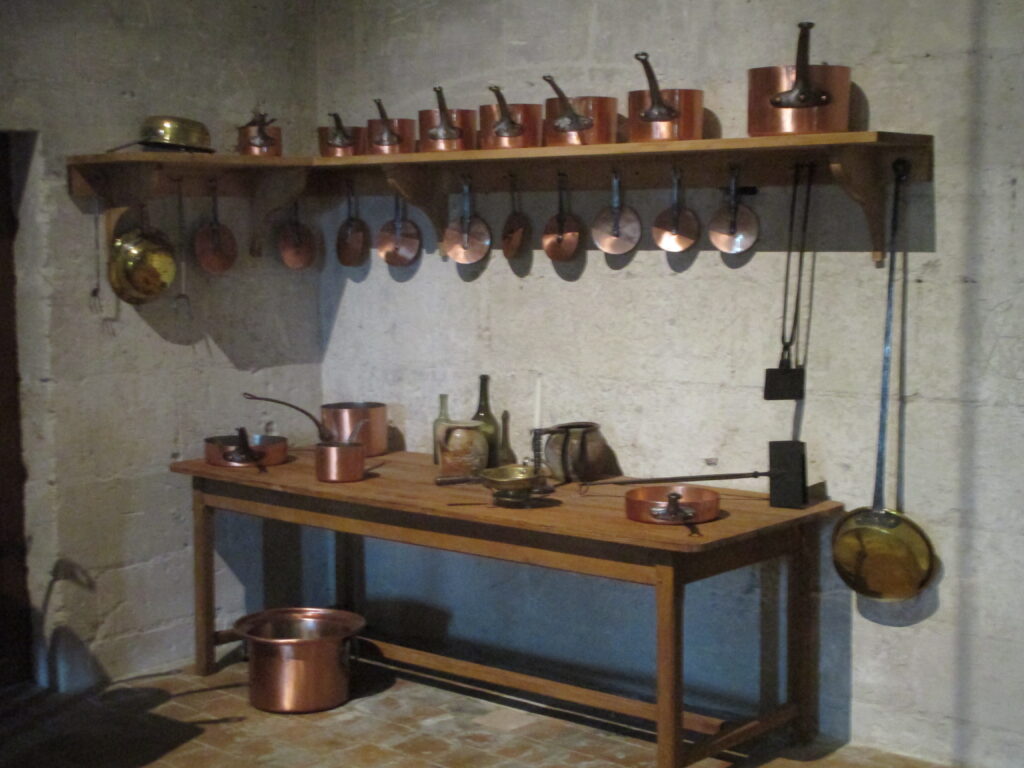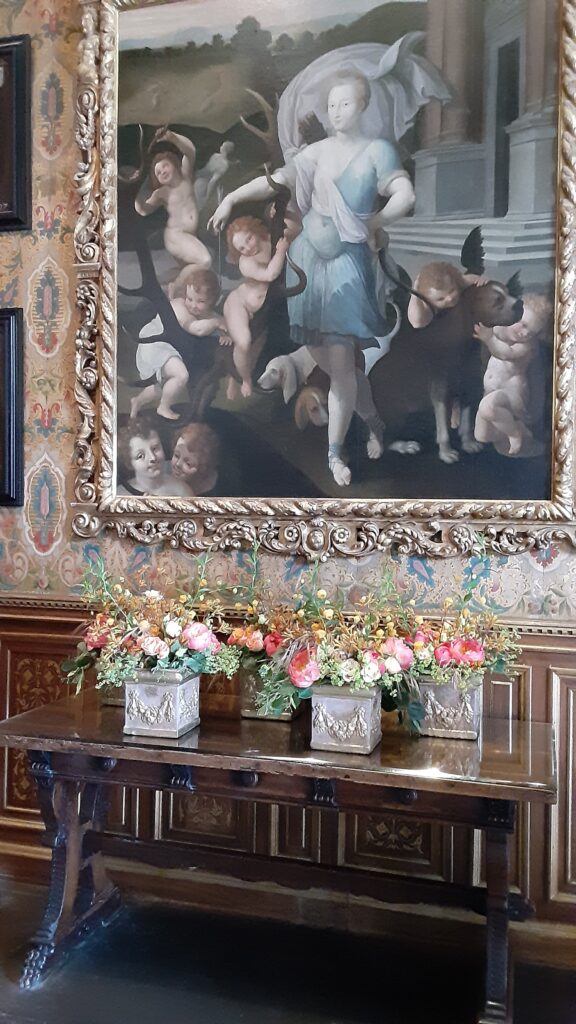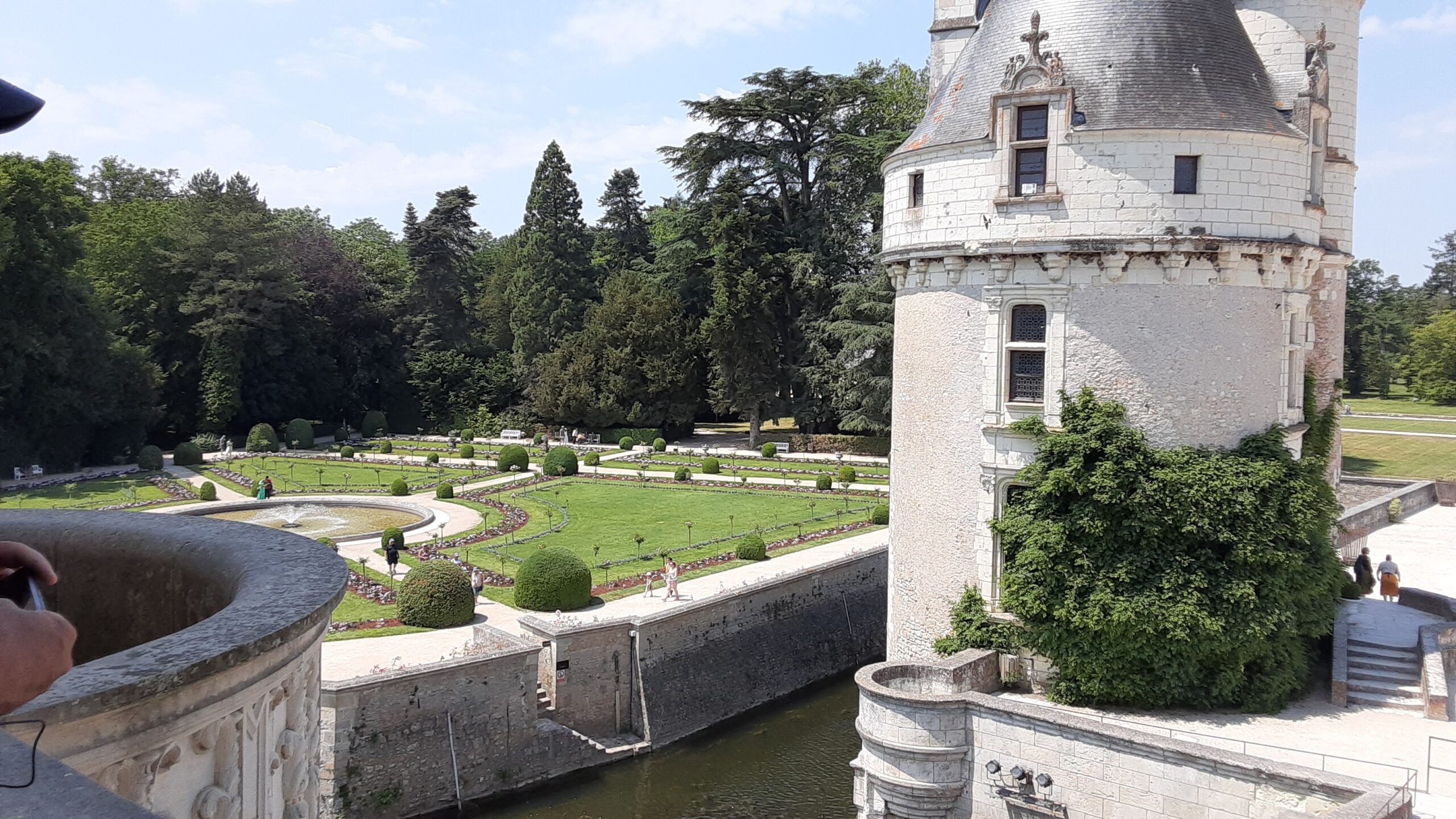Closing out June, I’m looking back at a great month. The tiny plants I put in last fall and spring have powered up and are looking more like a garden every day. The tour gardens for International Master Gardener Conference were amazing sources of inspiration. But without doubt, the month’s main highlight for me was our trip to France. We spent a week bicycling and visiting chateaux in the Loire Valley, something I’ve always wanted to do. Although not exactly gardening-focused, the trip could be considered gardening-adjacent, so I thought you might enjoy reading about it. After all, the Loire Valley is known as the garden of France.
Over the course of a week, we biked from Blois to Azay-le-Rideau. Our routes took us through farmland, charming villages, and on a trail beside the Loire. Here’s a typical sight.

You can see some other cyclists in the photo. The Loire à vélo is popular, especially with French people of retirement age. Everything was lovely; however, France is experiencing a drought. We couldn’t walk across the Loire, as was widely reported last August, but a bare band of sand along the banks showed that the water level was lower than normal. The air was hazy and colors wan. We cycled through vineyards, yes, but also through fields of bush beans—haricots verts, although they were more haricots jaunes, it appeared to me.
Although many of the villages had signs saying they were Ville Fleurie, I don’t think this meant they were full of flowers but rather that they offer a high quality of life.

Out of the 300-something chateaux in the Loire Valley, we visited Blois, Chambord, Chenonceau, Azay-le-Rideau, and Villandry. I’ve heard that for some people, chateaux get similar after seeing a couple, but for me that was not the case. Each was fabulous in its own way, and each was different. The first we visited was Chambord, where we ran into a crew filming the second season of the Starz drama The Serpent Queen, about Catherine de Médicis. I saw but didn’t photograph Samantha Morton dressed in black velvet, waiting in the heat. The crew spent 45 minutes setting up for three seconds of action. Here are the horses and carriages.

The show is mainly filmed on location. We’ve watched a few episodes and recognize many of the settings. Sometimes a scene will take place in a room we remember from Chenonceau, and then cut to an exterior from Villandry.
I’m not sure why I took these photos of Chambord’s kitchen, but I was excited when it turned up in the program.


All the chateaux (except Azay-le-Rideau) had gardens in the famous French-renaissance style: symmetric, bare of shade, with elaborate parterres enclosing lots of roses—the opposite of my wild garden. Sometimes the gardens’ most impressive quality was their size. A friend pointed out that they weren’t necessarily meant to be walked through, but to be viewed from a window.
Although visiting the chateaux wasn’t repetitive to me, this style of garden was. They were hot. We crowded into patches of shade. This photo captures the feeling of touring one after riding our bikes for twenty miles.

The Floral Workshop at Chenonceau
All these chateaux and gardens have been widely written about, so I was prepared for what I saw. However, I surprised and delighted by the flower arrangements at Chenonceau. They were incredible—amazingly varied and lush.

They’re the work of florist Jean-François Boucher, whose many awards include the “Meilleur Ouvrier de France,” and who has led the chateau’s floral atelier since 2015.

Boucher oversees preparation of bouquets for nineteen rooms twice weekly—about 200 bouquets each week. When possible, he sources many flowers from the chateau gardens and grounds, as you can see in this video, which also shows him working on a composition.
I like that he smiles so much.
Boucher mentions Arcimboldo as an inspiration, as well as his grandmother, who was also a florist. Formerly owner of his own shop in nearby Tours, he says he’s happy to be liberated from commercial pressures. He isn’t free of constraints, however. Each room has a predominant color scheme that influences the arrangements, like the blue velvet bed hangings in the chambre de Diane de Poitiers, the gold and wine tapestries decorating the chambre de Catherine de Médicis, and the black-and-white floor in the gallery over the River Cler.

The chateau’s interiors were largely empty, with just a few pieces of period furniture, and the flower arangements brought suggestions of life and death, and intimacy into the formal rooms. The effect was astonishing. Boucher posts pictures of his creations on Instagram, a twice-weekly, and his photos are much better than my snapshots. If you’re thinking of visiting, the atelier offers workshops and master classes. I believe Christmas is a special season for them. Also, last year (2022) the chateau hosted the Grand Concours Floral Interflora, an international floral exhibit and competition.
As I’ve mentioned, I spent some time in France after college working at La Varenne, Anne Willan’s cooking school in northern Burgundy. This was a fabulous experience, but I haven’t traveled much throughout France, and I haven’t been able to return until now. I have been hearing about the Loire Valley chateaux since I started studying French in sixth grade, and have always longed to see them in person. Now I have!
Update: how my garden is growing
Here at home, our ribbon of flowers is filling out. We got our first compliment the other day when somebody walking by said he liked it.

We’re not going to win yard of the month, however. The grass has just flat-out died. The lawn is a dirt patch. I’m not sure why, but I don’t think I can do anything about it until temperatures drop.
I have learned a couple things. The rabbits are delighted to find so much delicious food , and they are responsible for the gap in the middle of my idea. The ate the Rudbeckia hirta and Coreopsis lanceolata down to the down to nubs, helped by their pals the chipmunks.
At any time of day, there’s a rabbit sitting in the middle of the yard, munching. You know the t-shirt cannon at the baseball games? I imagine one under our bushes shooting out rabbits. It’s so frustrating. I’ve doused the plants with cayenne pepper, mulched with human hair. My neighbors must think I’m growing wire cages. My dad asked, “Do those things work to keep the animals out?” Sadly, no.
If I had it to do over, I’d plant more of the things the rabbits do not like: Eastern Blue Star (Amsonia tabernaemontana), Hairy Wild Petunia (Ruellia humilis), and Calamint (Clinopodium arkansanum), which had lovely, tiny lavender flowers. The salvia, although not native, doesn’t interest them and is crawling with bees.
For the most part, these are good times. So far I’ve only seen one Japanese beetle! In July I plan to concentrate on watering, pruning, and watching birds eat my grapes. I’m happy to share.
Thanks for reading!

